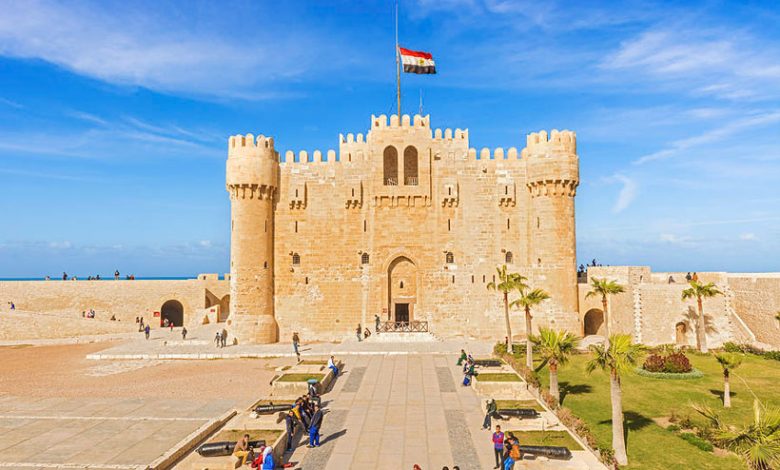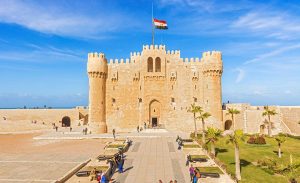TOURS OF EGYPT

QAITBAY FORT, EGYPT

REGARDING QAITBAY FORT:
Qaitbay Fort is one of Alexandria’s most well-known and often visited attractions. Furthermore, it is Egypt’s only and finest example of Mamluk military architecture. Visitors to Alexandria are strongly encouraged to see the Qaitbay Fort. The defensive fortress known as the Citadel of Qaitbay is located on the Mediterranean Sea shoreline close to Alexandria, Egypt (also known as the Fort of Qaitbay; Arabic:). Sultan Al-Ashraf Sayf al-Din Qait Bay erected it between 1477 and 1479 AD (882 and 884 AH). The Citadel, at the mouth of Eastern Harbour, marks the northernmost point of Pharos Island’s eastern side.
LIGHTHOUSE OF ALEXANDRIA:
On the easternmost point of Pharos Island, the Citadel is located close to the eastern port entrance. On the identical spot where the renowned Lighthouse of Alexandria, one of the Seven Wonders of the Ancient World, formerly stood, it was built. Up until the Arab invasion, the lighthouse was in operation. The lighthouse underwent a few minor architectural changes as a result of subsequent catastrophes, but it continued to be used. Ahmed Ibn Tulun was the first to employ restoration (about 880 AD). An earthquake that happened in the eleventh century damaged the octagonal portion.The top was turned into a modest mosque, while the bottom was preserved but could only function as a watchtower. An extremely strong earthquake that occurred in the fourteenth century entirely demolished the entire structure.
15TH-CENTURY FORTIFICATIONS:
The Circassian Mameluke Sultan Al-Ashraf Qaitbay fortified the region around 1480 AD as part of his coastal defence systems against the Turks, who at the time threatened Egypt. He built the fortification and a mosque to go with it. The Citadel was mostly in use during the Mameluke, Ottoman, and Modern periods, but after the British raid on Alexandria in 1882, it was hidden from view. It was regularly renovated by the Egyptian Supreme Council of Antiquities when it deteriorated throughout the 20th century.
The Citadel of Qaitbay is said to have been built by a Circassian Sultan named Al-Ashraf Abou Anasr Saif El-Din Qaitbay El-Jerkasy Al-Zahiry (1468-1496 AD), who was born around 1423 AD (826 AH). He was a Mamluke who just had 20 years old when he landed in Egypt. Al-Ashraf Bersbay bought him, and he remained with him until Al-Ashraf Bersbay’s death. Later, Qaitbay was bought by the Sultan Jaqmaq, who later liberated him. Qaitbay held a number of posts after that. He attained the rank of Chief of the Army under Sultan Timurbugha (Atabec Al-Askar).
Qaitbay was selected to become the Sultan and granted the title Almalek Al-Ashraf on Monday, 26th Ragab, 872 AH (1468 AD). One of the most famous and well-known Mameluke Sultans, he ruled for almost 29 years. Almalek Al-Ashraf, a brave ruler, tried to forge a new era with the Ottomans by trading presents and sending emissaries. He was a travel enthusiast and took part in several renowned trips.
THE QAITBAY FORT’S ORIGINS AND HISTORY:
The renowned fort was built in 1477 as per an order from the Mamluk Sultan Al Ashraf Qaitbay. Using the lighthouse’s remaining stones, the fort was built atop the ruins of the renowned ancient lighthouse.
It was finished in 1479, two years later. Its construction was initiated in order to defend Alexandria from external dangers, particularly those posed by the Ottomans, who at the time commanded a sizable naval force.
Construction:
Ibn Ayas claims that the building of the Qaitbay fort started in the month of Rabi al-Awal 882 H. He asserted that when touring Alexandria’s location of the previous lighthouse with a small group of Mameluke princes, Sultan Qaitbay gave the order to build the Citade.
The Sultan Qaitbay returned to Alexandria while the structure was being constructed in the month of Shaban 884 H. He provided the fort with a brave legion of soldiers and a range of weapons. Ibn Ayas asserts that he established additional waqfs and used the funds raised to finance construction projects and pay the military.
Thanks to its advantageous location and all the monarchs who succeeded Qaitbay, the Citadel was maintained in excellent shape throughout the Mameluke dynasty.
Fortification of the garrison:
The Sultan Qansuh al-Ghuri focused on the Citadel. He returned again, bringing the garrison various tools and increasing its size. It comprised a huge prison for the princes and statemen the Sultan kept away from him for any reason. Beginning in the year 960 H, Qansuh Al-Ghouri travelled to Alexandria alongside other kings.
APPROACH OF THE OTTOMAN THREAT:
He witnessed military drills and manoeuvres while they were on the way there that made use of the Citadel of Qaitbay’s available defensive armaments. He issued a military order prohibiting the removal of weapons from the Citadel after sensing the Ottoman threat, and he even threatened to execute anyone caught trying to remove anything from the Citadel. On a marble slate that was attached to the court door, this instruction was also written. The following text appears: Bi-smi-ll-hi ram-ni ram-hi-m We pray to the tremendously loving and merciful God.
Any member of the tower party who disobeys this (decree) and leaves the tower with something shall be hanged at the tower’s gate and will suffer the curse of God, whether they are Mameluke, Slaves, or Zarad Kashia. Al-Ashraf Abou El-Naser Qansoh El-Ghoury, may God eternalize his dominion, made this proclamation. Right now, it is 907 H Rabei Alawal.
Any member of the tower party who disobeys this (decree) and leaves the tower with something shall be hanged at the tower’s gate and will suffer the curse of God, whether they are Mameluke, Slaves, or Zarad Kashia. Al-Ashraf Abou El-Naser Qansoh El-Ghoury, may God eternalize his dominion, made this proclamation. Right now, it is 907 H Rabei Alawal.
OTTOMAN THREAT FALLS:
As the Ottoman force diminished, the Citadel began to lose some of its strategic importance. Because of its frailty and the supremacy of the French modern weapons at the time, the Citadel garrison was seized by French troops in 1798 AD during the French war against Egypt. There, the French found some crusader weapons that had been a part of an expedition led by Louis IX. These could have come from the plunder during the Al Mansurah Battle.
19TH-CENTURY RENOVATION:
When Muhammad Ali Pasha assumed control of Egypt in 1805, the exterior walls of the ancient Citadel were repaired and rebuilt. Additionally, he equipped the citadel with the most advanced armaments available, such as littoral artillery. Mohammed Ali’s administration may be regarded as the cause of the second golden age of The Citadel.
THE ORABI UPRISING:
The Citadel remained a point of interest for Mohammed Ali’s successors up until the Orabi Revolt in 1882. The majority of Alexandria was seriously damaged when the British fleet bombed it on July 11, 1882, especially the area close to the Citadel. The castle suffered serious damage as a result of this attack. The north and western façade of the building was severely damaged by direct cannon fire. The western facade, which was completely damaged, has large holes in it.
20TH-CENTURY RENOVATION:
The Ministry of Defense later repaired the upper floors of the Citadel in 1904 after they had been abandoned. King Farouk asked for an urgent renovation so that the Citadel could serve as a royal retreat.
Egyptian Naval Soldiers converted the building into a marine museum following the 1952 revolution. The fort had its most extensive repair in 1984 as a result of the ambitious restoration plans of the Egyptian Antiquities Organization.
ACCESSING QAITBAY FORT:
The western suburbs of Alexandria are home to Fort Qaitbay, which is strategically very advantageous. A significant appeal for tourists to Alexandria is the fort’s remarkable and distinctive construction, which makes it visible from almost anywhere along the city’s coastline.
QAITBAY FORT’S EVENTS AND ATTRACTIONS:
The intriguing features can be seen all over Fort Qaitbay. The fort is around 150 x 130 metres in size and is encircled by water on three sides. The focal point of the entire complex is the main tower or building of Fort Qaitbay.

The intriguing features can be seen all over Fort Qaitbay. The fort is around 150 x 130 metres in size and is encircled by water on three sides. The focal point of the entire complex is the main tower or building of Fort Qaitbay.
Fort Qaitbay’s three-story main tower is shaped like a semi-square. With a circle at each corner, this section consists of four towers. The oldest mosque and minaret in Alexandria are located in the tower.
Along with Luxor and Memphis, Egypt has additional important locations than Qaitbay Fort that are worth seeing. At this time, the list is not comprehensive. To learn, read these blogs.




